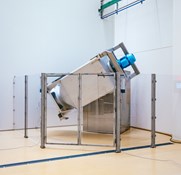


The use of pure functional meat proteins in the manufacture of pork, beef and chicken products is naturally in line with current nutritional trends. This creates opportunities for product developers.

© Veos
"Functional meat proteins are not only free from allergens and genetically modified material. Meat processors do not have to include an E-number on the packaging, either. The proteins can usually be declared as pork proteins," says Peter Vanhulle, area sales manager at Veos. This family business in Zwevezele produces both proteins based on porcine blood (plasma, globin, haemoglobin, hydrolysate) and proteins based on rind (collagen).
"The raw materials come from the abattoirs. The type of protein, its structure and its intrinsic product properties determine the characteristics of the unique ingredients," says Van Hulle. "The advantages include improved water binding, improved texture, reduced syneresis, improved emulsifying capacity and improved organoleptic characteristics for the meat products."
Nutri-Score
Animal protein ingredients are easily digested and also contribute to the nutritional value of the products, the sales manager explains, and this benefits the Nutri-Score. "This is about more than the excellent amino acid profiles of the proteins. Adding functional proteins not only increases the protein content, but at the same time reduces the fat content through protein and water." This can raise the Nutri-Score from, for example, D to C, Van Hulle reports. More and more consumers are setting great store by this.

© Veos
New ingredients
A new functional plasma protein from Veos is being used as a phosphate substitute in Frankfurter sausages. The research into the phosphate substitute was carried out in collaboration with the research group Meat Technology & Science of Protein-rich Foods, at KU Leuven Technology Campus Ghent. The meat industry is facing a challenge since the European Food Safety Authority (EFSA) has announced that it will reduce the maximum permitted levels of phosphates in meat preparations. The main purpose of the plasma protein is to improve the water retention and emulsifying capacity of the meat. The doctoral research showed that phosphate can certainly be replaced by the plasma protein.

What exactly will today's consumers want on their plates tomorrow? It is with this rather tricky question in mind that food companies are constantly striving to develop products that meet the needs of even the most discerning gourmets.

Protein-enriched food products offer convenience for those who should or would like to consume more protein. Generally, it is not necessary to consume these products.

“We are receiving a growing number of enquiries from our clients on the prevention of cross-contamination in the mixing and packaging of dry ingredients for the food industry", says Domien Sierens of Food Blending. “Hygiene and quality assurance are our top priorities".

At the Tavola gastronomic trade fair, from 17-19 March, Maisonie will launch four flavours of dessert with extra protein. In nutritional terms, two are sources of protein and two are rich in protein, Nathalie Van der Straeten tells us. She also reveals which plant proteins have been added.